- AI Fire
- Posts
- 🧬 1 Hour Of This AI Prep Will Save You 100+ Hours Of Study (Part 1)
🧬 1 Hour Of This AI Prep Will Save You 100+ Hours Of Study (Part 1)
Most people learn wrong by reading too soon. Use Perplexity and NotebookLM to build a map first. This saves you months of wasted effort and stress.
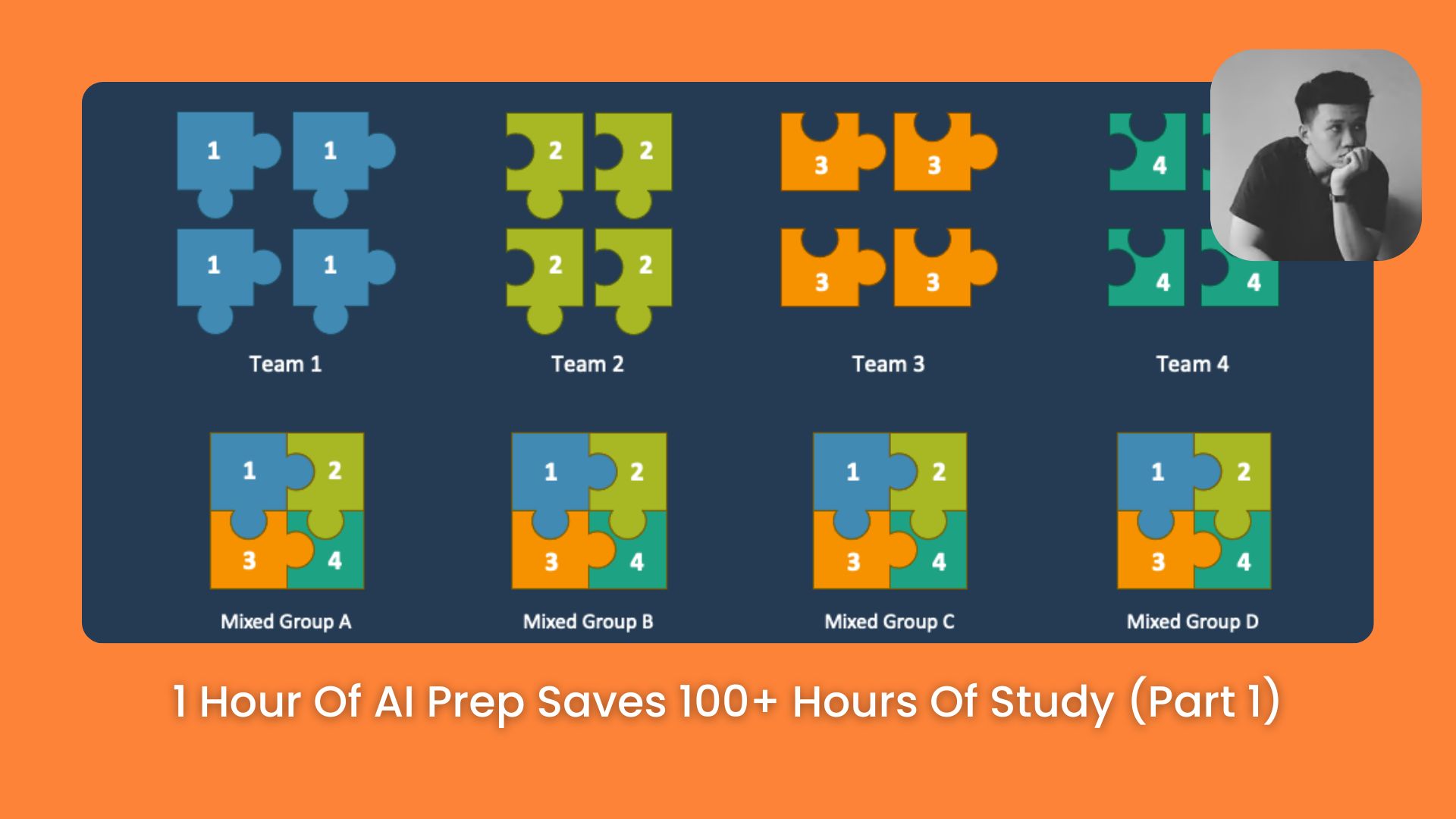
TL;DR
You can learn new skills 3x faster by focusing on the "setup phase" before you start studying. This involves defining a specific project goal and using AI tools to build a structural framework for your brain.
Most learners fail because they try to memorize details without a clear plan. This guide introduces the "Jigsaw Puzzle" method, where you build the big picture first. You will learn how to use Perplexity to find the best resources instantly and NotebookLM to create mental maps. This preparation prevents you from wasting time on irrelevant content.
Key points
Using AI for targeted research can save about 4 hours compared to manual Google searching.
Avoid setting vague input goals like "I want to learn Excel"; choose specific output goals instead.
Take an AI-generated quiz before studying to create "knowledge gaps" that improve memory retention.
Critical insight
The biggest cause of failure is not the difficulty of the material, but the lack of a tangible "output goal" that forces you to filter out unnecessary information.
🛑 What creates the biggest roadblock in your learning journey? |
Table of Contents
Introduction
Do you ever feel like you are running out of time? I often feel this way. The world moves very fast. New technology comes out every day. You might need to learn a new software for your job, or maybe you want to learn a new language to travel. But when you look at the size of the work, you feel tired before you even start.
I used to spend 3 to 4 months trying to learn a new skill. I would buy books, watch 20-hour video courses, and try to remember every small detail. It was exhausting. Usually, I would quit after two weeks because I did not see any progress.
But then, I changed my approach. I stopped trying to work harder, and I started working smarter. I built a system. By combining a clear plan with free AI tools, I reduced my learning time from months to just a few weeks.
This is not a magic trick. It is a logical process.
Because this system is detailed, I have divided it into two parts. In this first email, Part 1, we will focus on the preparation. This is the "hidden" work that makes the actual learning easy. We will talk about how to set the right goals, find the best materials without wasting time, and prepare your brain to learn.
Let’s begin.
Part I: How Should We Think About Learning?
1. The Jigsaw Puzzle Method
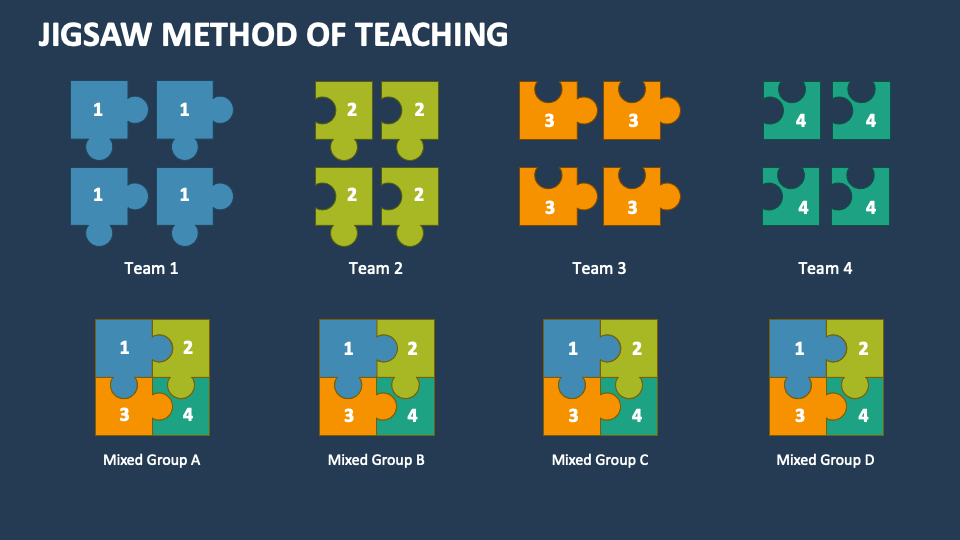
To learn fast, we must first change how we view the learning process.
Think about how you solve a jigsaw puzzle. Imagine you dump 1,000 pieces on the table. Do you pick up one random piece, look at it for 10 minutes, and try to memorize it? No. That would be impossible.
Instead, you do three things:
You look at the picture on the box to see the final result.
You sort the pieces to find the edges and corners.
You build the frame first.
Once the frame is ready, filling in the middle is much easier.
Traditional learning like in school is often the opposite. Teachers give us random pieces (dates, formulas, words) and tell us to memorize them. We don't see the big picture. This is why we forget everything after the exam.
In this system, we will look at the "box cover" first. We will build the frame using AI. When we have the frame, our brains will naturally want to fill in the missing pieces. This makes learning feel less like work and more like a game.
Learn How to Make AI Work For You!
Transform your AI skills with the AI Fire Academy Premium Plan - FREE for 14 days! Gain instant access to 500+ AI workflows, advanced tutorials, exclusive case studies and unbeatable discounts. No risks, cancel anytime.
Part II: What Is The First Step To Start?
1. Setting A Concrete Output Goal
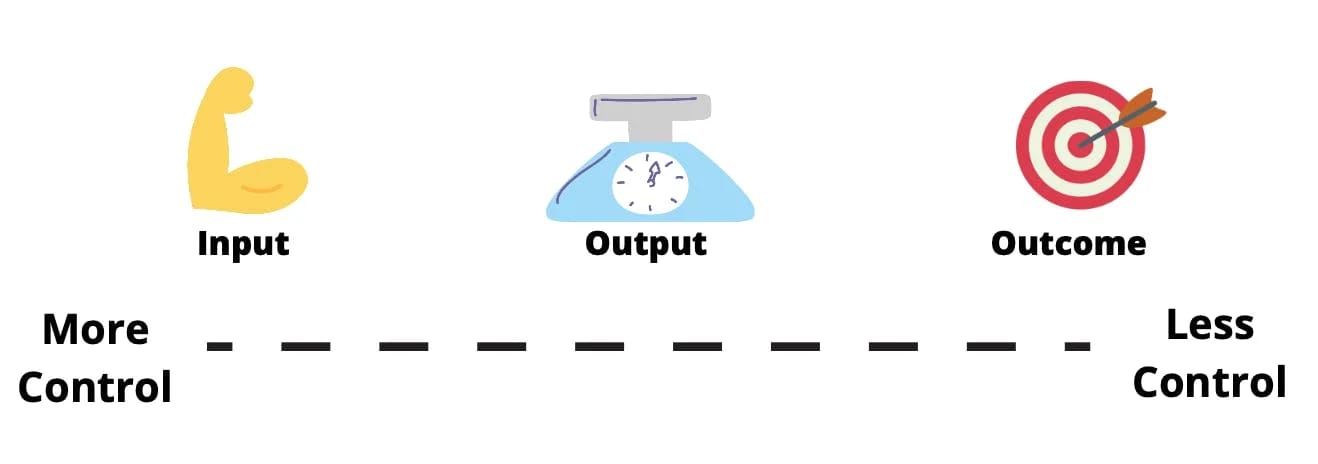
The biggest mistake I made in the past was setting "fuzzy" goals.
I would say things like: "I want to learn graphic design" or "I want to get better at writing."
These sound like good goals, but they are actually traps. "Learning graphic design" is too big. It never ends. Does it mean designing a logo? Making a website? Drawing a cartoon? Because the goal is not clear, you will waste time studying things you do not need.
You must switch your mindset from "Input" to "Output."
Input Goal: "I will watch 10 hours of tutorials." (Bad)
Output Goal: "I will create 3 posters for a fake coffee shop brand using Adobe Illustrator." (Good)
2. The "Can I Show It?" Test
To know if your goal is good, ask yourself: "Can I show the result to a friend?"
You cannot show a friend "knowledge." But you can show them a poster, a spreadsheet, or a video.
Here are some examples of how to fix bad goals:
Bad Goal: "I want to learn Excel."
Good Goal: "I want to create a personal budget spreadsheet that automatically calculates my monthly savings using formulas like VLOOKUP and SUMIF by next Saturday."
Bad Goal: "I want to learn about Artificial Intelligence."
Good Goal: "I want to write a 1,000-word article about the history of AI and publish it on a blog by the end of this month."
When you have a specific Output Goal, you save time immediately. You can ignore every YouTube video or article that does not help you reach that specific finish line.
Part III: How Do I Find The Best Study Materials?
Once you have your goal, you need resources (books, videos, articles). In the past, I would go to Google and type "How to learn Python."
This is dangerous.
Google will give you millions of results. Many are old. Many are just trying to sell you a simpler course. Many are written by people who don't actually know the topic. You can spend 5 or 6 hours just clicking links and feeling confused. This is the "Rabbit Hole."
2. Using AI As A Research Assistant
Now, I never start with Google. I use Perplexity.
This tool is different. It reads the internet for you and gives you a summary. It acts like a smart friend who has read every forum and review site.
My strategy is to find "Crowdsourced Wisdom." I don't want to know what a company thinks is best (because they are selling something). I want to know what real students think is best.
Here is the exact prompt I use in Perplexity:
"I am a complete beginner who wants to learn [Topic: e.g., Video Editing with CapCut]. My specific goal is to [Goal: e.g., create a 1-minute travel vlog for TikTok with music and transitions]. Act as an expert researcher. Please search Reddit, specialized forums, and learner communities to find the '80/20' resources. I want to find the top 3 most recommended tutorials or free courses that teach the fundamentals quickly. For each recommendation, explain why people like it and list one negative thing about it."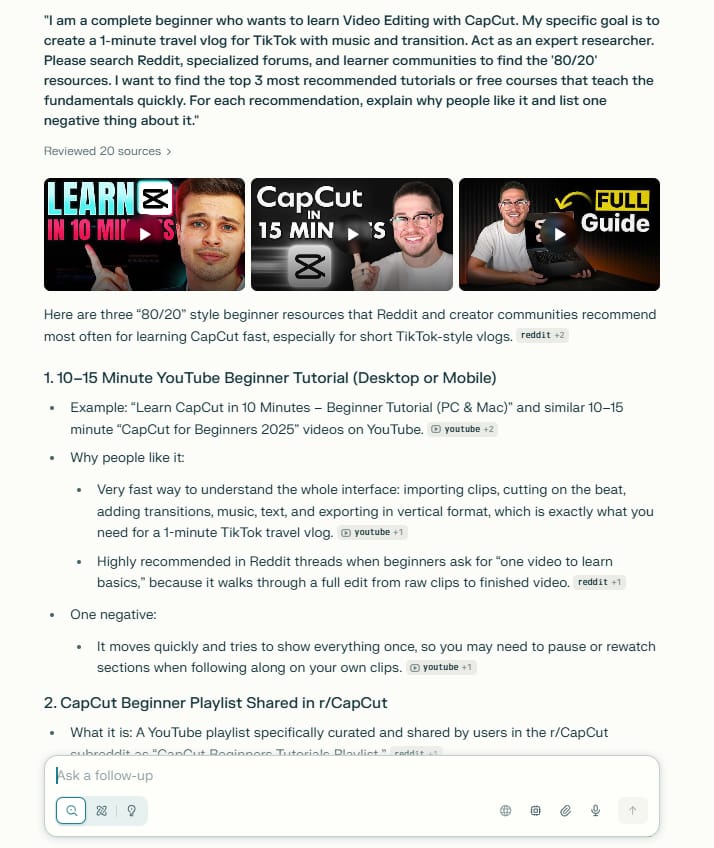
Why this prompt works:
"Reddit and forums": It looks for real human discussions, not marketing blogs.
"80/20 resources": It asks for the 20% of materials that give 80% of the results.
"One negative thing": This helps you trust the result. No course is perfect.
When I use this, Perplexity usually gives me a specific YouTube playlist or a free website that everyone recommends. I save about 4 hours of searching.
Part IV: What Should I Do Before I Start Studying?
1. The Concept Of "Priming"
Most people find their resources and immediately start reading Chapter 1. This is a mistake.
Imagine you are going to paint a wall. You don't just put paint on the dirty wall. First, you clean it. Then you put on a "primer" coat. This makes the real paint stick better and look brighter.
Your brain needs a "primer" too. This step is called Priming.
Priming means scanning the information to build a mental map before you try to understand the details. It prepares your brain to receive new data.
2. Creating A "Cheat Sheet" With AI
I use NotebookLM for this step. It is a fantastic free tool from Google.
Let's say I found a very long PDF textbook or a transcript of a 3-hour video lecture. I do not read it yet. I upload it to NotebookLM. Then, I ask it to give me the "Map."
Here is the prompt I use in NotebookLM:
"I am about to study this document. I need you to create a 'Mental Map' for me. Please list the 5 most critical concepts I must understand to master this topic. For each concept, provide a simple 1-sentence definition. Also, list the 10 most common jargon words I will encounter. Do not give me long explanations yet. I just want the structure."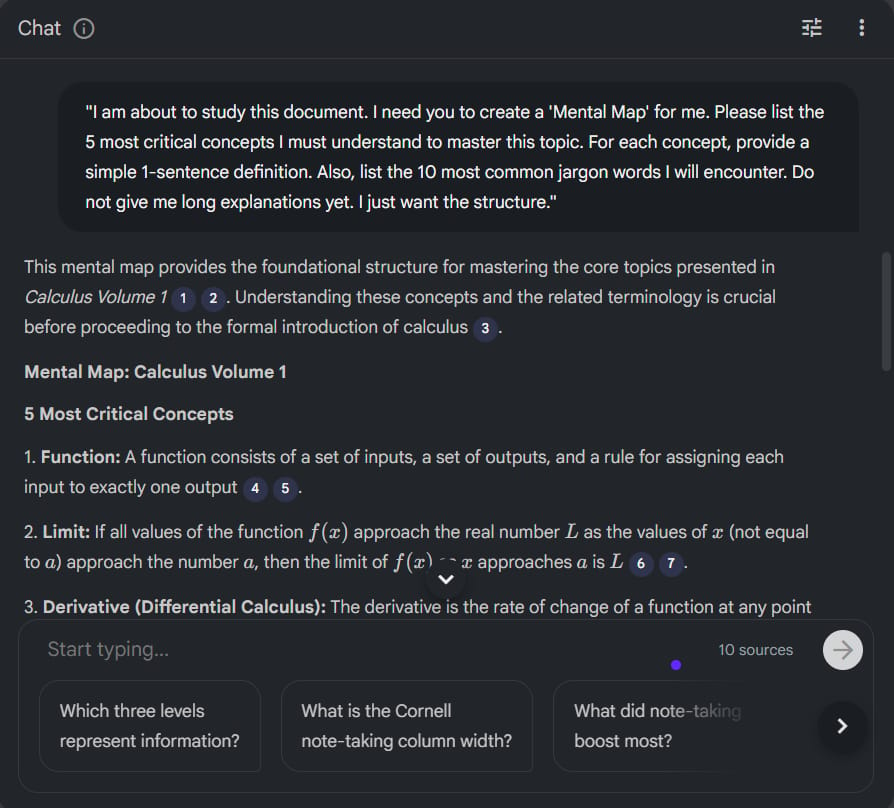
I read this AI output in 5 minutes. Now, when I start studying for real, and I see a word like "algorithms," my brain says, "Hey! I saw that word on the list. It is important." This helps me pay attention.
3. The "Fail First" Technique
This is my favorite trick. It sounds scary, but it works very well. I ask the AI to give me a test before I learn anything.
Yes, you will fail the test. You might get 0% correct. That is the point.
When you read a question and you don't know the answer, your brain gets curious. It opens a "gap." It starts looking for the answer. It is like when you hear half of a joke; you really want to hear the end.
Here is the prompt I use in NotebookLM:
"Based on the text I uploaded, create a 10-question multiple-choice quiz about the most important ideas. I want to test my knowledge before I start studying. Please provide the questions, but do not show me the answers until I ask for them."
I take the quiz. I guess the answers. I get them wrong. Then, I look at the correct answers.
Now, my brain is awake. I am not just passively reading; I am hunting for information. Research shows this can increase your memory retention significantly.
Summary Of Part 1
So far, we have not even started "studying" in the traditional sense. But look at what we have achieved:
We have a specific Output Goal (building a project, not just "learning").
We used Perplexity to find the absolute best resources, avoiding bad advice.
We used NotebookLM to create a map and a pre-test to wake up our brains.
This setup usually takes me about 1 to 2 hours. In the old days, I would have spent 1 week just worrying and searching.
Now that the foundation is ready, we can start the actual learning process. In Part 2, I will show you my "Layered Learning" technique. I will also show you how to use ChatGPT as a 24/7 personal tutor who never gets tired of your questions, and how to finally build your project.
See you in the next part.
If you are interested in other topics and how AI is transforming different aspects of our lives or even in making money using AI with more detailed, step-by-step guidance, you can find our other articles here:
Master AI Marketing: Build Your 24/7 Digital Assistant Without Code!
Earn Money with MCP in n8n: A Guide to Leveraging Model Context Protocol for AI Automation*
Transform Your Product Photos with AI Marketing for Under $1!*
The AI Secret To Reports That Clients Actually Implement
*indicates a premium content, if any
How useful was this AI tool article for you? 💻Let us know how this article on AI tools helped with your work or learning. Your feedback helps us improve! |
Reply